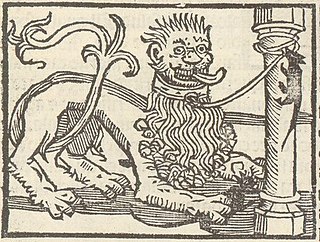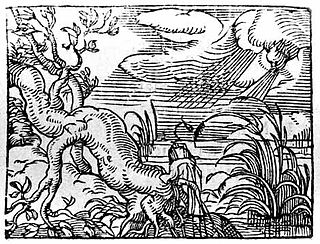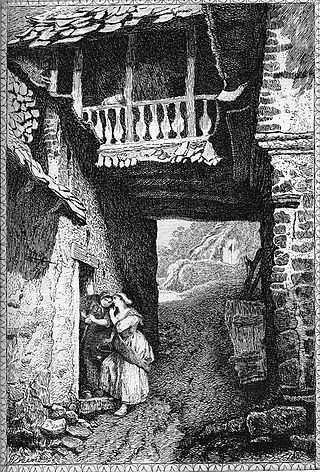
The Young Widow is a fable of Italian origin, made famous by being included in La Fontaine's Fables (VI.21). Originally a cynical attack on female inconstancy, later treatments were more thoughtful.

The Young Widow is a fable of Italian origin, made famous by being included in La Fontaine's Fables (VI.21). Originally a cynical attack on female inconstancy, later treatments were more thoughtful.
The fable originally appeared in Laurentius Abstemius' collection of humorous fables, the Hecatomythium (1492).
There was a woman, still young, whose husband was dying, and her father consoled her, saying, "Don't get so upset, daughter, for I have found you another man, more handsome than that one by far, who will easily soften your longing for your former husband." But the woman, chafing at her grief, like someone pursuing her husband out of burning love, not only refused to listen to her father's words but even denounced him for the untimely mention of another husband. But when she saw that her husband was deceased, amidst the tears and grieving, she asked her father whether that young man was there, whom he had said he wanted her to marry. [1]
Soon afterwards a close translation appeared in the English jest book Merry Tales and Quick Answers (c.1530), [2] but in general the trend among later fabulists has been to embroider upon the rather threadbare narration of Abstemius. La Fontaine softens the sarcasm by making the change of attitude less immediate in his treatment of the story [3] while Charles Denis in his 1754 translation of La Fontaine lengthens the period further and explains the change as simply the effect of time. [4]
La Fontaine's delicately ironical interpretation of the fable is reflected in later artistic treatments, such as Lambron Des Piltières' odd mixture of the Classical and the contemporary in La Jeune Veuve. But Ambrose Bierce brings a blacker humour to his Fantastic Fables, where the story is subverted under the title "The Inconsolable Widow". This tells of a passer-by attempting to comfort a woman weeping beside a grave with the assurance that 'there is another man somewhere, besides your husband, with whom you can still be happy'. The woman answers that she agrees, and that this is where he is buried. [5]
Marc Chagall included an etching of the grieving widow among the set of illustrated fables he published in 1952. [6] In 1995 Ida Gotkovsky (1933-) included it in her Hommage à Jean de La Fontaine for children's choir and orchestra; in 1999 Isabelle Aboulker set the fable for high voice and piano as the first of her four Femmes en fables. [7]

Ivan Andreyevich Krylov is Russia's best-known fabulist and probably the most epigrammatic of all Russian authors. Formerly a dramatist and journalist, he only discovered his true genre at the age of 40. While many of his earlier fables were loosely based on Aesop's and La Fontaine's, later fables were original work, often with a satirical bent.

Aesop's Fables, or the Aesopica, is a collection of fables credited to Aesop, a slave and storyteller who lived in ancient Greece between 620 and 564 BCE. Of varied and unclear origins, the stories associated with his name have descended to modern times through a number of sources and continue to be reinterpreted in different verbal registers and in popular as well as artistic media.

The Ant and the Grasshopper, alternatively titled The Grasshopper and the Ant, is one of Aesop's Fables, numbered 373 in the Perry Index. The fable describes how a hungry grasshopper begs for food from an ant when winter comes and is refused. The situation sums up moral lessons about the virtues of hard work and planning for the future.

The Lion and the Mouse is one of Aesop's Fables, numbered 150 in the Perry Index. There are also Eastern variants of the story, all of which demonstrate mutual dependence regardless of size or status. In the Renaissance the fable was provided with a sequel condemning social ambition.
Laurentius Abstemius, born Lorenzo Bevilaqua, was an Italian writer and professor of philology, born at Macerata Feltria; his learned name Abstemius, literally "abstemious", plays on his family name of Bevilaqua ("drinkwater"). A Neo-Latin writer of considerable talents at the time of the Humanist revival of letters, his first published works appeared in the 1470s and were distinguished by minute scholarship. During that decade he moved to Urbino and became ducal librarian, although he was to move between there and other parts of Italy thereafter as a teacher.

Special Delivery (1997) is a romantic novel written by Danielle Steel.

The Bear and the Travelers is a fable attributed to Aesop and is number 65 in the Perry Index. It was expanded and given a new meaning in mediaeval times.

The Milkmaid and Her Pail is a folktale of Aarne-Thompson-Uther type 1430 about interrupted daydreams of wealth and fame. Ancient tales of this type exist in the East but Western variants are not found before the Middle Ages. It was only in the 18th century that the story about the daydreaming milkmaid began to be attributed to Aesop, although it was included in none of the main collections and does not appear in the Perry Index. In more recent times, the fable has been variously treated by artists and set by musicians.

The Mouse Turned into a Maid is an ancient fable of Indian origin that travelled westwards to Europe during the Middle Ages and also exists in the Far East. The story is Aarne-Thompson type 2031C in his list of cumulative tales, another example of which is The Husband of the Rat's Daughter. It concerns a search for a partner through a succession of more powerful forces, resolved only by choosing an equal.

The Oak and the Reed is one of Aesop's Fables and is numbered 70 in the Perry Index. It appears in many versions: in some it is with many reeds that the oak converses and in a late rewritten version it disputes with a willow.
Still waters run deep is a proverb of Latin origin now commonly taken to mean that a placid exterior hides a passionate or subtle nature. Formerly it also carried the warning that silent people are dangerous, as in Suffolk's comment on a fellow lord in William Shakespeare's play Henry VI part 2:

The Walnut Tree is one of Aesop's fables and numbered 250 in the Perry Index. It later served as a base for a misogynistic proverb, which encourages the violence against walnut trees, asses and women.

The miller, his son and the donkey is a widely dispersed fable, number 721 in the Perry Index and number 1215 in the Aarne–Thompson classification systems of folklore narratives. Though it may have ancient analogues, the earliest extant version is in the work of the 13th-century Arab writer Ibn Said. There are many eastern versions of the tale and in Europe it was included in a number of Mediaeval collections. Since then it has been frequently included in collections of Aesop's fables as well as the influential Fables of Jean de la Fontaine.
The drowned woman and her husband is a story found in Mediaeval jest-books that entered the fable tradition in the 16th century. It was occasionally included in collections of Aesop's Fables but never became established as such and has no number in the Perry Index. Folk variants in which a contrary wife is sought upstream by her husband after she drowns are catalogued under the Aarne-Thompson classification system as type 1365A.
The title of Shakespeare's Jest Book has been given to two quite different early Tudor period collections of humorous anecdotes, published within a few years of each other. The first was The Hundred Merry Tales, the only surviving complete edition of which was published in 1526. The other, published about 1530, was titled Merry Tales and Quick Answers and originally contained 113 stories. An augmented edition of 1564 contained 140.
The title of The Woodcutter and the Trees covers a complex of fables that are of West Asian and Greek origins, the latter ascribed to Aesop. All of them concern the need to be wary of harming oneself through misplaced generosity.

Jean de La Fontaine collected fables from a wide variety of sources, both Western and Eastern, and adapted them into French free verse. They were issued under the general title of Fables in several volumes from 1668 to 1694 and are considered classics of French literature. Humorous, nuanced and ironical, they were originally aimed at adults but then entered the educational system and were required learning for school children.

The Heron and the Fish is a situational fable constructed to illustrate the moral that one should not be over-fastidious in making choices since, as the ancient proverb proposes, 'He that will not when he may, when he will he shall have nay'. Of ancient but uncertain origin, it gained popularity after appearing among La Fontaine's Fables.

The women and the secret is a sly fable by La Fontaine (VIII.6), based on a piece of Late Mediaeval misogynistic humour relayed by Laurentius Abstemius.

The Weasel and Aphrodite, also known as Venus and the Cat is one of Aesop's Fables, numbered 50 in the Perry Index. A fable on the cynic theme of the constancy of one's nature, it serves as a cautionary tale against trusting those with evil temper, for even if they might change their body, they will not change their mind.